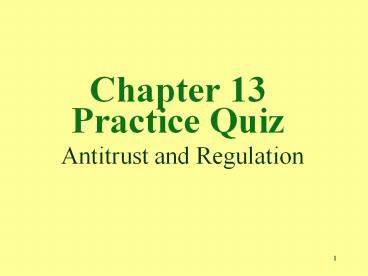Chapter 13 Practice Quiz Antitrust and Regulation PowerPoint PPT Presentation
Title: Chapter 13 Practice Quiz Antitrust and Regulation
1
Chapter 13Practice Quiz Antitrust and
Regulation
2
- Which of the following is illegal under the
Sherman Act? - a. Attempts to monopolize.
- b. Price fixing.
- c. Formation of cartels.
- d. All of the above are illegal.
D. The Sherman Act of 1890 is the federal
antitrust law to curb trusts, but the federal
government did not win a notable case until 1911.
3
- 2. Officers of five large building-materials
companies meet and agree that none of them will
submit bids on government contracts lower than an
agreed-upon level. This is an example of - a. price fixing.
- b. vertical restriction.
- c. a tying contract.
- d. an interlocking directorate.
A. The Sherman Act was enacted with vague
language, but price fixing is clearly a
conspiracy in restraint of trade.
4
- 3. A fabric shop cannot sell Singer sewing
machines if it also sells other brands of sewing
machines. This is an example of - a. a resale price maintenance.
- b. territorial restrictions.
- c. a tying agreement.
- d. exclusive dealing.
D. If the effect is to substantially lessen
competition such an agreement between a
manufacturer and a retailer is a violation of the
Clayton Act of 1914.
5
- 4. Under the Clayton Act, horizontal mergers
- by stock acquisition were
- a. not considered.
- b. illegal if they could be shown to lessen
- competition.
- c. illegal under any circumstances.
- d. legal if they could be shown not to lessen
- competition.
B. Horizontal mergers are combinations among
competitors in the same industry which, if
allowed, eliminate existing competition.
6
- 5. Under the Clayton Act, which of the following
was illegal even if it was not shown to lessen
competition substantially? - a. Price discrimination.
- b. Tying contracts.
- c. Horizontal mergers by stock acquisition.
- d. Interlocking directorates.
- Interlocking directorates is the situation in
which a director of one company serves on the
board of directors of a competing company.
7
- 6. The importance of the Federal Trade
- Commission Act of 1914 is that it
- set up an independent antitrust agency with the
power to investigate complaints. - b. strengthened the law against mergers.
- c. strengthened the law against price
- discrimination.
- d. none of the above.
A. The FTC Act of 1914 established a five-member
commission appointed by the president to
investigate unfair methods of competition.
8
- 7. Which of the following is concerned primarily
with price discrimination? - a. Sherman Act.
- b. Clayton Act.
- c. Robinson -Patman Act.
- d. Celler-Kefauver Act.
C. The Robinson-Patman Act of 1936 is an
amendment to the Clayton Act that strengthens the
Clayton Act against price discrimination.
9
- 8. Which of the following is concerned
- primarily with mergers?
- a. Sherman Act.
- b. Clayton Act.
- c. Robinson-Patman Act.
- d. Celler-Kefauver Act.
D. The Celler-Kefauver Act is called the
antimerger act because it closed the loophole
in the Clayton Act by prohibiting mergers by sale
of physical assets.
10
- 9. The Utah Pie case was brought under
- which of the following laws?
- a. Sherman Act.
- b. Federal Trade Commission Act.
- c. Robinson-Patman Act.
- d. Celler-Kefauver Act.
C. Utah Pie was a small frozen dessert pie firm
in Salt Lake City that used three outside
national competitors for price discrimination.
The Supreme Court ruled in Utah Pies favor.
11
- 10. Although U.S. Steel controlled nearly 75
percent of the domestic iron and steel industry,
in 1920 the Supreme Court ruled that the firm was
not in violation of the Sherman Act because
there was no evidence of abusive behavior. What
antitrust doctrine was the Court applying in this
case? - a. The rule of reason.
- b. The per se rule.
- c. The marginal cost pricing rule.
- d. The natural monopoly rule.
A. The rule of reason applied when a firm was not
engaged in anticompetitive behavior.
12
- 11. In which antitrust case did the courts first
apply the per se rule to determine whether a firm
was in violation of the Sherman Act? - a. The Standard Oil case.
- b. The Alcoa case.
- c. The IBM case.
- d. The MIT case.
B. The court decision in the Alcoa case of 1945
replaced the rule of reason with the per se rule,
which states that the mere existence of monopoly
is illegal.
13
- 12. The Interstate Commerce Commission
- (ICC) was established in
- a. 1887.
- b. 1890.
- c. 1929.
- d. 1933.
A. The ICC was established for the original
purpose of regulating rail prices by reducing
duplicate trains, depots, and tracks.
14
- 13. Today, the Civil Aeronautics Board (CAB)
regulates airline - a. ticket prices.
- b. routes.
- c. safety.
- d. all of the above.
- e. none of the above the CAB was abolished in
1984.
E. The CAB was established in 1938 to regulate
airline fares and air routes.
15
- 14. Which of the following provides the
- basis for regulation?
- a. Natural monopoly.
- b. Externalities.
- c. Imperfect information.
- d. All of the above.
D. In each of these cases, the argument in favor
of regulation is market failure.
16
- 15. Consider a regulated natural monopoly. If the
regulatory commission wants to establish a
fair-return price, then it should set a price
ceiling where the demand curve crosses the
monopolys long-run - a. marginal revenue curve.
- b. average revenue curve.
- c. marginal cost curve.
- d. average cost curve.
D. One method for regulators to establish a
fair-return price is to set price equal to
long-run average cost and the monopolist earns
zero economic profit.

